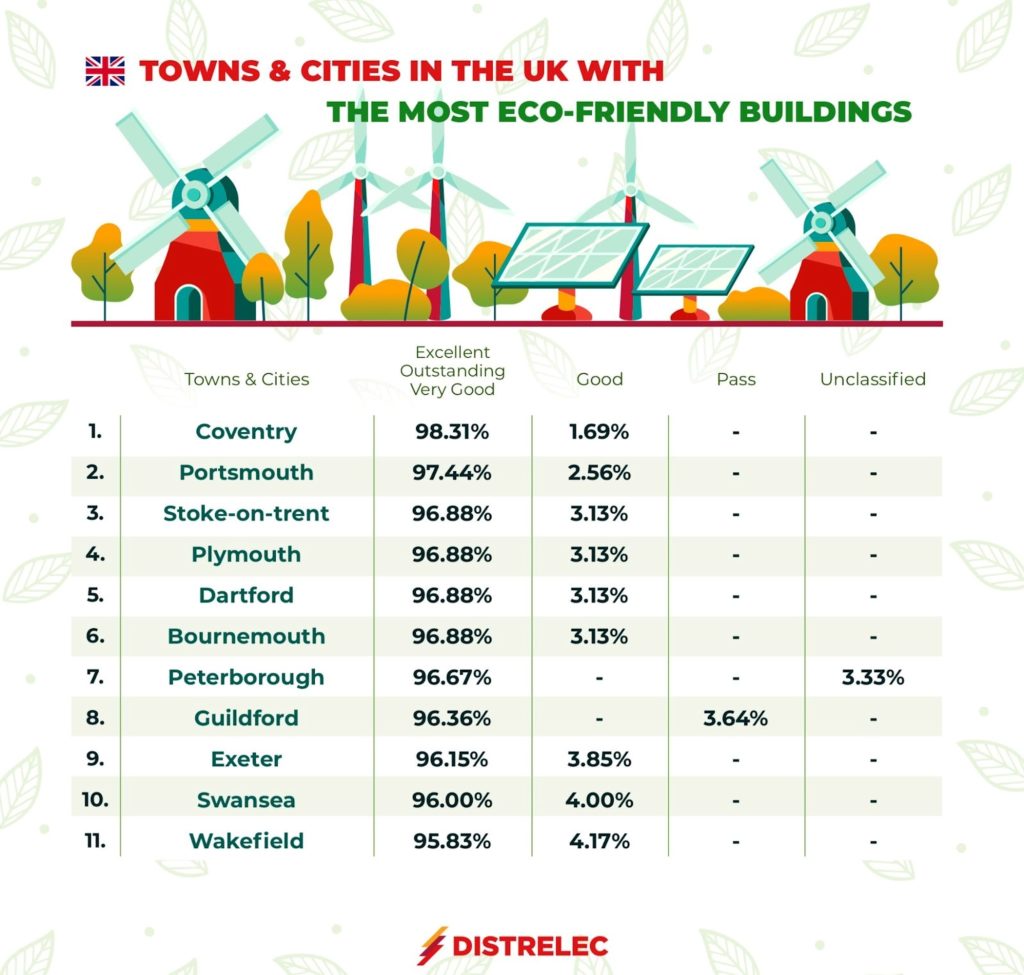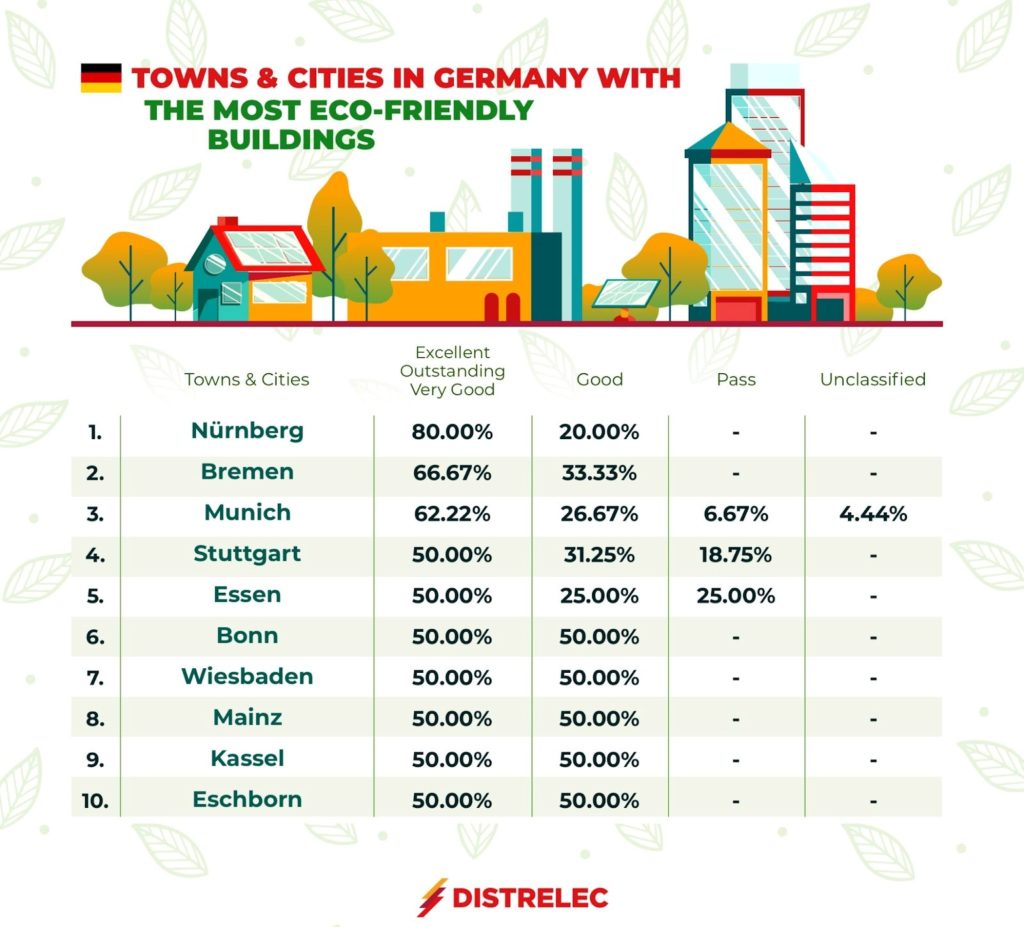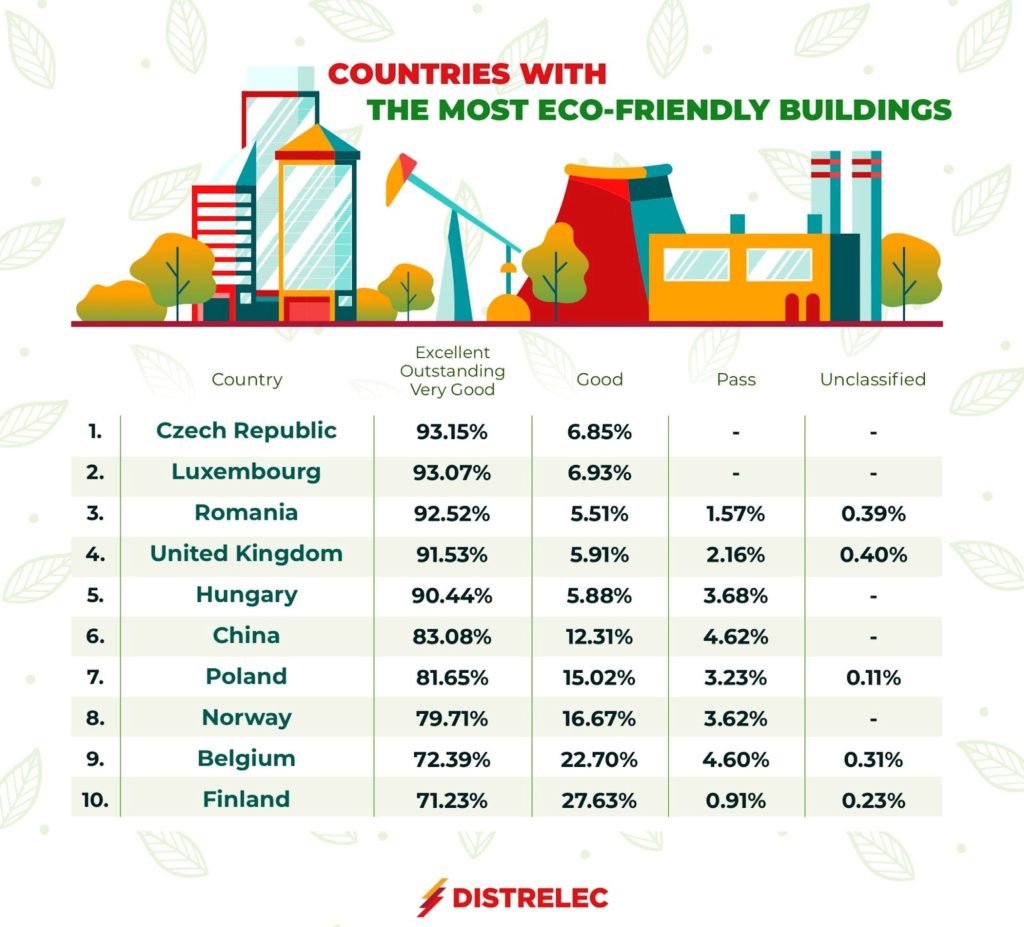UK City Claims Prime Position with Eco-Friendly Buildings but the Czech Republic Climbs to Top of the Class Amongst Countries.
Green living is something we should all be striving for with a climate crisis on the horizon and fossil fuels running low but it’s not always easy to achieve. More and more people are taking it upon themselves to live cleaner, greener lives but this is far more effective when the infrastructure is in place and policy encourages more sustainable living standards.
One way of helping this is by making sure the buildings in which people live and work are more eco-friendly so that the very environments in which we survive and thrive are helping us towards a more sustainable future. But which towns and cities are taking the time to invest in eco-friendly infrastructure and what countries are taking the environmental impacts of their buildings most seriously?
BREEAM is an international scheme that assesses the sustainability of individual buildings (amongst other things) and provides independent certification. Gauging buildings on how well they meet the stringent environmental standards on energy, health and well-being, innovation, land use, management, pollution, materials, transport, waste and water, a grade is given to these buildings to reflect the performance of the building in these areas.
Each of these categories is then divided into a range of assessment issues with a benchmark to be achieved and a credit is awarded when this target is met. A category rating of Excellent, Outstanding, Very Good, Good, Pass and Unclassified.
Using BREEAMs ratings, Distrelec looked at towns and cities across the globe to see how they ranked in terms of achieving these grades with a building receiving an Excellent, Outstanding or Very Good grouped into one category whilst Good, Pass and Unclassified remained as their individual groupings. With each area having a different number of buildings certified by BREEAM, we turned the data into percentages to more accurately reflect the differences between them.

Of the many global cities and towns that data was gathered from, Coventry in Central England came out on top with a whopping 98.31% of the buildings certified by BREEAM falling into the Outstanding/Excellent/Very Good category with a further 1.69% coming in as Good. A former industrial powerhouse, Coventry was heavily damaged during the Second World War and has seen major investment and restructuring in the post-war years, becoming a noted University city, which may go some way to explain how it scores quite so highly.
Polish city Krakow is not far off with an impressive 97.65% of its buildings rated by BREEAM coming into that top category and another 1.18% rated as Good. Interestingly, of the remaining top 10, eight are English towns and cities with Czech capital Prague rounding out the list with an impressive 96.27% of its ranked buildings falling into that top band.

The towns and cities in the UK that have ranked highest for their excellent, outstanding and very good buildings alongside Coventry are Portsmouth, the port city and naval base on the south coast of England, the city Stroke-on-Trent and another port city, Plymouth. Interestingly three of the towns and cities in the top list are coastal towns on the south coast, this could be due to being in close proximity to green initiatives such as wind farms.
Dartford finds itself placed around the middle of the table. Notably, the town’s football club was awarded a Green Heart Hero trophy for the ‘Sustainability in Sport’ category after they launched the world’s first purpose-built eco-friendly football stadium in 2006, willing for other clubs to follow suit.
Towards the lower end of the list, Exeter still has a commendable 96.15% of buildings in the top category, whilst 3.85% are rated as Good. It has also been reported that new eco-friendly development with a strong focus on low-carbon properties is due to be completed this Spring in Ringswell Avenue, whilst similarly in Wakefield, there are plans to develop 175 eco-friendly buildings over the course of the next year.

60% of the locations mentioned in the top list for France are communes, the smallest and oldest administrative division in France representing all parts of a town under the same name.
All of the communes from the above list are located in Paris, which may not come as a surprise after The Paris Agreement was introduced in 2016. The treaty, adopted by 196 parties at COP21, is an agreement focused on climate change with a goal concentrated on limiting global warming. This extends to building development, with a strong emphasis on establishing eco-friendly patterns of long term, sustainable development.
According to a recent article, Paris has a plan in place to become ‘Europe’s Greenest City’ by 2030, and the number of communes included in this list is a testament to that.

Nürnberg is the second-largest city in Bavaria after Munich, however, whilst the area may be smaller, it boasts more buildings in the top category with 80% of them meeting these criteria. The capital tells a slightly different story, placing 3rd in our study with 62.22%.
Formerly referred to as the ‘Green Roof Capital of Europe’, Stuttgart made an impression in 2019 when it became known for rooftops covered with grass and vegetable gardens alongside flower displays, in a bid to tackle air pollution and contribute to habitats for wildlife to thrive in. Not to mention, also based in Stuttgart is the German Sustainable Building Council, founded in 2007.
Further down our table is the city of Essen, which was named the ‘European Green Capital’ in 2017. With 50% of its buildings in the Excellent, Outstanding and Very Good categories, alongside 25% in Good, the city is also one of the greenest by area, due to the amount of green space and woodland.

With so many English places ranking so highly, you’d think the UK would easily top the list of countries with the most eco-friendly buildings under BREEAMS ratings but whilst it scores impressively overall, with 91.53% of those buildings falling into the top band, it only sneaks into the top four as the Czech Republic managed to strike back to claim top spot with 93.15% of its rated buildings coming into that superior classification. Perhaps more shockingly, when taking a national overview, 0.40% of the UK’s buildings that undertook the BREEAM assessment came out as unclassified.
There was a slight change to the criteria of nations being ranked in this study as only a country with 100 or more buildings rated by BREEAM were eligible. As such, China is the only non-European country to make the list coming in at a not-too-shabby sixth position. This may surprise many given that there is a perception that China is a large polluter, but this is largely due to its population of over 1.4 billion people but its view to modern infrastructure allows it to keep its environmental impact per capita fairly low.
Of course, this data is not entirely representative of which nations take environmentalism seriously when undertaking new construction projects as it only reflects those that have used the BREEAM rating system, but what it does show is those that are certainly taking great efforts to try and build a more sustainable future.










